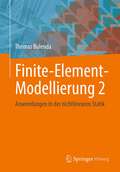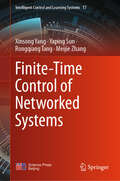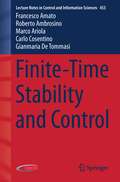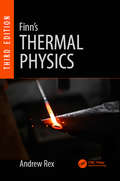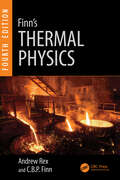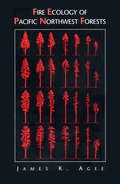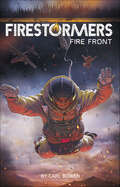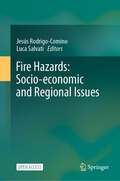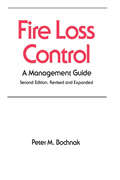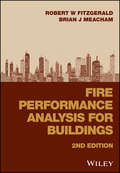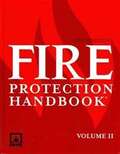- Table View
- List View
Finite-Element-Modellierung 2: Anwendungen in der nichtlinearen Statik
by Thomas BulendaEs gibt eine Vielzahl von „Wie-erstelle-ich-ein Finite-Element-Programm?“-Lehrbüchern, aber nur recht wenige Veröffentlichungen zur Frage „Wie wende ich ein Finite-Element-Programm an?“. Dieses Buch legt den Schwerpunkt auf die zweite Fragestellung. Es basiert auf den Vorlesungen zur Anwendung der Finite-Element-Methode, die der Autor seit 1998 an der OTH Regensburg hält. Deren Inhalte kommen aus seiner Tätigkeit als Prüfingenieur für Baustatik in einem großen Münchener Ingenieurbüro. Behandelt werden sowohl Fragestellungen, mit denen sich jeder Ingenieur konfrontiert sieht, wenn er Berechnungen mit einem Finite-Element-Programm erstellen will, als auch Problempunkte, die im Büro des Autors im Zuge einer Projektbearbeitung auftraten und auf den ersten Blick gar nicht so klar waren. Der 2.Teil des zweibändigen Werkes befasst sich mit Themen aus der nichtlinearen Statik.
Finite-Time Control of Networked Systems (Intelligent Control and Learning Systems #17)
by Xinsong Yang Yaping Sun Rongqiang Tang Meijie ZhangThis book mainly provides recent advances in finite-time and fixed-time control issues for complex networks and neural networks. It is well known that finite-time techniques have more advantages over asymptotical ones. Besides fast convergence rates, finite-time techniques have better robustness and disturbance rejection properties. However, it is challenging to deal with time delay in studying finite-time control. For readers’ easy understanding, the finite-time control issue for systems with and without time delays is separately introduced in this book. Moreover, the issues of finite-time and fixed-time control for differential equations with discontinuous states on the right-hand side are also considered. Many interesting results concerning finite-time and fixed-time synchronization are provided in the form of lemmas, theorems, or corollaries, accompanied by systematic theoretical analysis for the proof of their sufficient conditions, controller design, and new analysis techniques. Each new result is verified by at least one numerical example with detailed data analysis. Therefore, this book is an advantageous tool and is beneficial for interested experts and scholars in the control field.
Finite-Time Sliding Mode Control for Markov Jump Systems: Transient Performance Analysis and Design (Studies in Systems, Decision and Control #603)
by Yugang Niu Zhiru CaoThis book focuses on the transient performance implementation of Markov jump systems under state/output constraints, using the sliding mode control method. Both finite-time boundedness and input-output finite-time stability under engineering practice have been addressed, with weight placed on control theory and engineering practice. This is achieved by providing an in-depth study on several major topics such as fault-tolerant control, component-wise control, non-fragile control, security control, and hybrid control. The major features of the book include 1) providing a systematic and comprehensive design framework for the treatment of finite-time issues via sliding mode control; and 2) updating the complete design scheme for mode-dependent sliding mode controller via correction of reachability analysis, which is particularly suited for readers who are interested to learn finite-time sliding mode control and sliding mode control for Markov jump systems. The book benefits researchers, engineers, and graduate students in the fields of control science and engineering, mathematics, etc.
Finite-Time Stability and Control
by Francesco Amato Roberto Ambrosino Marco Ariola Carlo Cosentino Gianmaria De TommasiFinite-time stability (FTS) is a more practical concept than classical Lyapunov stability, useful for checking whether the state trajectories of a system remain within pre-specified bounds over a finite time interval. In a linear systems framework, FTS problems can be cast as convex optimization problems and solved by the use of effective off-the-shelf computational tools such as LMI solvers. Finite-time Stability and Control exploits this benefit to present the practical applications of FTS and finite-time control-theoretical results to various engineering fields. The text is divided into two parts: · linear systems; and · hybrid systems. The building of practical motivating examples helps the reader to understand the methods presented. Finite-time Stability and Control is addressed to academic researchers and to engineers working in the field of robust process control. Instructors teaching graduate courses in advanced control will also find parts of this book useful for their courses.
Finn's Thermal Physics
by Andrew Rex C.B.P. FinnThis fully updated and expanded new edition continues to provide the most readable, concise, and easy-to-follow introduction to thermal physics. While maintaining the style of the original work, the book now covers statistical mechanics and incorporates worked examples systematically throughout the text. It also includes more problems and essential updates, such as discussions on superconductivity, magnetism, Bose-Einstein condensation, and climate change. Anyone needing to acquire an intuitive understanding of thermodynamics from first principles will find this third edition indispensable. Andrew Rex is professor of physics at the University of Puget Sound in Tacoma, Washington. He is author of several textbooks and the popular science book, Commonly Asked Questions in Physics.
Finn's Thermal Physics
by Andrew Rex C.B.P. FinnThis fully updated and expanded new edition continues to provide the most readable, concise, and easy-to-follow introduction to thermal physics.While maintaining the style of the original work, the book now covers statistical mechanics and incorporates worked examples systematically throughout the text. It also covers more problems, and incorporates some essential updates, such as discussions on superconductivity, magnetism, Bose-Einstein condensation, and climate change.Anyone who needs to acquire an intuitive understanding of thermodynamics from the first principles will find this third edition indispensable.Selling Points• Provides the most concise and accessible introduction to thermodynamics starting from first principles, with many more worked examples and problems.• Incorporates statistical mechanics in two brand-new chapters.• Systematically incorporates more worked examples after introducing a new concept to show what the results mean numerically.• Continues to address the subtleties in a way unmatched by any other text, for topics such as the meaning of thermodynamic functions.• Offers a significant update on areas such as superconductivity, magnetism, Bose-Einstein condensation, climate change, and physics of information.Andrew Rex is a professor of physics at the University of Puget Sound in Tacoma, Washington. He earned a BA in physics at Illinois Wesleyan University in 1977 and a PhD in physics at the University of Virginia in 1982. At Virginia he worked under the direction of Bascom S. Deaver Jr on the development of new superconducting materials. After completing requirements for his PhD, he joined the faculty at Puget Sound. Dr Rex’s primary research interest is in the foundations of the second law of thermodynamics. He has published research articles and, jointly with Harvey Leff, two comprehensive monographs on the subject of Maxwell’s demon (1990, 2003). Dr Rex has coauthored several widely used textbooks—Modern Physics for Scientists and Engineers (1993, 2000, 2006, 2013, 2021), Integrated Physics and Calculus (2000), and Essential College Physics (2010, 2021)—and the popular science book Commonly Asked Questions in Physics, also published by Taylor & Francis/CRC Press.
Fins Furs and Feathers: Abraham Dee Bartlett And The Invention Of The Modern Zoo
by Cassandre MaxwellAbraham Dee Bartlett knew from a young age that he wanted to spend his life working with animals. But in Victorian London, there weren’t many jobs that provided an opportunity to do that. Still, Abraham spent years gaining knowledge and pursuing his dream until he eventually became superintendent in the London Zoo. Driven by his compassion for the animals, Abraham dramatically improved the conditions of the zoo to ensure that the animals could be happy and healthy. With engaging back matter and charming illustrations, Cassandre Maxwell’s book brings to life the little-known story of the man who helped to create the modern zoo.
Fins, Wings, and Legs
by Rachel Griffiths Margaret ClyneComplete Classroom Library includes one each of the following: Math LibraryScience LibrarySocial Studies LibraryContent Area Classroom Libraries include: 1 display box containing 10 6-packs (60 little books)1 Teacher Resource Portfolio1 Assessment Book (where available)Big Book Collection includes: 10 Big Books for Science10 Big Books for Social Studies10 Big Books for MathClassroom Library Add-on Packs include 1 copy of each title from the social studies, science, and math libraries. Add-On Packs include 1 copy of each title.
Fintech and Sustainability: How Financial Technologies Can Help Address Today’s Environmental and Societal Challenges
by Thomas Walker Maher Kooli Elaheh Nikbakht Harry J. TurtleFintech can improve sustainability, influence policies, and require new regulations. Climate change, water pollution, and non-renewable resources management can all be addressed with fintech innovations. Despite the advantages offered by fintech, opponents warn of potential negative consequences. The application of fintech in sustainability is a double-edged sword requiring further investigation. This book provides an overview of fintech applications and considers their impact on the future of sustainable finance. It explores how financial technologies can enhance the sustainability of investment and corporate decisions and contribute to the fulfillment of the Sustainable Development Goals (SDGs). By considering practitioner and academic views, it examines whether and how fintech can improve sustainable practices, potential threats with possible solutions, and policies and regulations designed to improve sustainability benefits.
Fintech-Lexikon: Begriffe für die digitalisierte Finanzwelt
by Stefan Huch Rainer AltDieses Buch hilft dem Leser im Umfeld der Digitalisierung bei der Begriffsklärung und stellt einschlägiges Know-how zur Verfügung. Was bedeutet 42? Was ist eine Subchain? Was ist der Unterschied zwischen Robotics und Artificial Intelligence? Der Schwerpunkt liegt dabei auf den Entwicklungen, die seit 2010 mit der Digitalisierung unter dem Namen "Financial Technology" eine zunehmende Verbreitung erlebt haben. Die Begrifflichkeiten umfassen grundlegende Begriffe, die Eingang in die allgemeine Sprache gefunden haben, wie etwa Artificial Intelligence oder Blockchain, aber auch fachspezifische Termini, die für das Verständnis der einzelnen Technologien notwendig sind (zum Beispiel 42, Nonce). Die Fintech-Terminologie bietet dem Leser einen konzisen und gleichzeitig anschaulich dargestellten alphabetisch geordneten Überblick mit den darin enthaltenen praxisorientierten Antworten.
Fire
by Sebastian JungerSebastian Junger details his first-hand experiences as he describes fire fighting. As a seasoned journalist he travels the world and brings the reader face to face with many crises.
Fire Ants And Leaf-cutting Ants: Biology And Management
by Clifford S. Lofgren Robert K. Vander MeerThe 1985 Research Conference on Fire Ants and Leaf-Cutting Ants covered the most recent developments in research and control of these insect pests of the New World tropical and subtropical zones, the southern United States, South and Central America, and the Caribbean Islands. This volume contains chapters that discuss the history and economics, biology and ecology, behavior, pheromones and other semiochemicals, physiology, and biochemistry of fire ants and leaf-cutting ants, as well as current and future control strategies. The information provided illustrates past and present agricultural and medical problems associated with these pest ants; however, it also brings out the point that they may at times be beneficial. The chapters on basic aspects of the biology and ecology of the ants provide up-to-date information that is useful for a more complete understanding of their social behavior and the unique symbiotic relationship between leaf-cutting ants and their fungi. New approaches to control are illustrated by innovative research on anti-feedant chemicals from plants that prevent feeding by leaf-cutting ants. The present status of chemical baits and biocontrol is addressed, as well as the possibilities of future novel methods based on the use of anti-metabolites, insect hormones, behavior modifying substances, and species-specific toxic bait systems to create integrated pest management systems.
Fire Ecology and Management: Past, Present, and Future of US Forested Ecosystems (Managing Forest Ecosystems #39)
by Beverly Collins Cathryn H. GreenbergThis edited volume presents original scientific research and knowledge synthesis covering the past, present, and potential future fire ecology of major US forest types, with implications for forest management in a changing climate. The editors and authors highlight broad patterns among ecoregions and forest types, as well as detailed information for individual ecoregions, for fire frequencies and severities, fire effects on tree mortality and regeneration, and levels of fire-dependency by plant and animal communities. The foreword addresses emerging ecological and fire management challenges for forests, in relation to sustainable development goals as highlighted in recent government reports. An introductory chapter highlights patterns of variation in frequencies, severities, scales, and spatial patterns of fire across ecoregions and among forested ecosystems across the US in relation to climate, fuels, topography and soils, ignition sources (lightning or anthropogenic), and vegetation. Separate chapters by respected experts delve into the fire ecology of major forest types within US ecoregions, with a focus on the level of plant and animal fire-dependency, and the role of fire in maintaining forest composition and structure. The regional chapters also include discussion of historic natural (lightning-ignited) and anthropogenic (Native American; settlers) fire regimes, current fire regimes as influenced by recent decades of fire suppression and land use history, and fire management in relation to ecosystem integrity and restoration, wildfire threat, and climate change. The summary chapter combines the major points of each chapter, in a synthesis of US-wide fire ecology and forest management into the future.This book provides current, organized, readily accessible information for the conservation community, land managers, scientists, students and educators, and others interested in how fire behavior and effects on structure and composition differ among ecoregions and forest types, and what that means for forest management today and in the future.
Fire Ecology in Rocky Mountain Landscapes
by William L. BakerFire Ecology in Rocky Mountain Landscapes brings a century of scientific research to bear on improving the relationship between people and fire. In recent years, some scientists have argued that current patterns of fire are significantly different from historical patterns, and thatlandscapes should be managed with an eye toward reestablishing past fire regimes. At the policy level, state and federal agencies have focused on fuel reduction and fire suppression as a means of controlling fire. Geographer William L. Baker takes a different view, making the case that the available scientific data show that infrequent episodes of large fires followed by long interludes with few fires led to naturally fluctuating landscapes, and that the best approach is not to try to change or control fire but to learn to live with it. In Fire Ecology in Rocky Mountain Landscapes, Baker reviews functional traits and responses of plants and animals to fire at the landscape scale; explains how scientists reconstruct the history of fire in landscapes; elaborates on the particulars of fire under the historical range of variability in the Rockies; and considers the role of Euro-Americans in creating the landscapes and fire situations of today. In the end, the author argues that the most effective action is to rapidly limit and redesign people-nature interfaces to withstand fire, which he believes can be done in ways that are immediately beneficial to both nature and communities.
Fire Ecology of Florida and the Southeastern Coastal Plain
by Reed F. NossAn overview of the importance of fire to ecosystems in the Southeast, with guidance on how to best conduct controlled burns in the regionA biodiversity hotspot, Florida is home to many ecosystems and species that evolved in the presence of frequent fire. In this book, Reed Noss discusses the essential role of fire in generating biodiversity and offers best practices for using fire to keep the region's ecosystems healthy and resilient. Reviewing several lines of evidence, Noss shows that fire has been important to the southeastern Coastal Plain for tens of millions of years. He explains how the region's natural fire regimes are connected to its climate, high rate of lightning strikes, physical chemistry, and vegetation. But urbanization and active fire suppression have reduced the frequency and extent of fires. Noss suggests the practice of controlled burning can and should be improved to protect fire-dependent species and natural communities from decline and extinction. Noss argues that fire managers should attempt to simulate natural fire regimes when conducting controlled burns. Based on what the species of the Southeast likely experienced during their evolutionary histories, he makes recommendations about pyrodiversity, how often and in what seasons to burn, the optimal heterogeneity of burns, mechanical treatments such as cutting and roller-chopping, and the proper use of fuel breaks. In doing so, Noss is the first to apply the new discipline of evolutionary fire ecology to a specific region. This book is a fascinating history of fire ecology in Florida, an enlightening look at why fire matters to the region, and a necessary resource for conservationists and fire managers in the state and elsewhere.
Fire Ecology of Pacific Northwest Forests
by James K AgeeThe structure of most virgin forests in the western United States reflects a past disturbance history that includes forest fire. James K. Agee, an expert in the emergent field of fire ecology, analyzes the ecological role of fire in the creation and maintenance of natural western forests, focusing primarily on forest stand development patterns. His discussion of the natural fire environment and the environmental effects of fire is applicable to a wide range of temperate forests.
Fire Escape: How Animals and Plants Survive Wildfires (Books for a Better Earth)
by Jessica StremerA timely middle grade nonfiction overview of the incredible ways animals detect, respond, and adapt to wildfires, as well as how climate change is affecting the frequency and severity of these devastating events in nature.Goats and beavers. Drones and parachutes. Pinecones and beetles. What do they have in common? Believe it or not, they are all crucial tools in fighting, preventing, and adapting to wildfires!These vicious fires are spreading faster and burning hotter than at any other time in history. Ongoing droughts, warming weather, and a history of poor forest management have extended the traditional wildfire season beyond the summer months. It is a matter of life and death for wildlife worldwide.This breathtaking nonfiction book focuses on unique angles to a hot topic, including injury rehabilitation efforts, species that use wildfires to their advantage, how to help area repopulation, and the animals that help to prevent/fight wildfires. A riveting, kid friendly text is accompanied by stunning woodcut illustrations and full-color photographs, as well as extensive back matter with glossary, sources, and index.Books for a Better Earth are designed to inspire children to become active, knowledgeable participants in caring for the planet they live on.A Junior Library Guild Gold Standard Selection
Fire Front (Firestormers)
by Carl BowenAs the son of a state senator, Jason Garrett had most of his life handed to him on a silver platter. His father even pulled a few strings to secure him a top spot on the world’s newest, most elite wildfire fighting crew: the FIRESTORMERS. But standing on front lines against hundred-foot walls of 2,000-degree flames, Garett must rely on his own courage, heart, and crewmates to survive.
Fire Hazard Assessment of Lithium Ion Battery Energy Storage Systems
by Andrew F. Blum R. Thomas LongProviding a concise overview of lithium-ion (Li-ion) battery energy storage systems (ESSs), this book also presents the full-scale fire testing of 100 kilowatt hour (kWh) Li-ion battery ESSs. It details a full-scale fire testing plan to perform an assessment of Li-ion battery ESS fire hazards, developed after a thorough technical study. It documents the results of the testing plan including external and internal ignition testing, ESS positioning, temperature and heat flux measurements, pressure measurement, weather meters, and data acquisition systems. A comprehensive literature review and gap analysis reveal the current state of research into this vital aspect of energy storage. The authors cover the characteristics and hazards of Li-ion batteries, their anatomy and design, commercial and residential ESSs, historical fire incidents, and ESS codes and regulations. Researchers and professionals working in fire protection engineering, battery systems engineering, or energy storage will find this book a useful example of a fire testing plan. The results of the hazard assessment offer insights for those involved in electrical, fire, and building codes, as well as practitioners in design standards and fire testing.
Fire Hazard and Fire Resistance of Wooden Structures
by Sivenkov Andrey Borisovich Berlin Alexander Alexandrovich Mukhamedgaliev Bakhtiyor Abdukadirovich Almenbayev Mirzhan Maratovich Makishev Zhandos Kuandykovich Berik Zhambulovich RakhmetulinThis monograph discusses fire hazard and fire resistance in wooden structures with a long duration of operation. Aside from its increasing importance for modern architecture, wood has been the most important building material in the past. It has a distinct aesthetic, high mechanical strength, and resistance against many environmental changes. These properties are evident in structures like the still standing Grinstead Chuch, which has been built in 1045. Readers will however learn about the decreasing fire resistance in wooden buildings with a long service live. Considering the cultural value of medieval wood buildings, this topic becomes increasingly relevant. The chapters discuss the mechanical, physico-chemical and thermophysical properties of wooden structures over different lifespans. Many factors contributing to the changing fire resistance in the ageing process of wooden structures, are explained. This book is a valuable resource for students, teachers and scientists in the areas of wood science, fire research and forestry.
Fire Hazards: Socio-economic and Regional Issues
by Jesús Rodrigo-Comino Luca SalvatiThe open access book aims to show the readers novel, relevant and reproducible power of synergistic collaborations between European research groups and stakeholders with the objective to synthesize the existing knowledge and expertise about fire management and hazard and defining a concerted research agenda that promotes an integrated approach to create fire-resilient landscapes, taking into account biological, biochemical and physical, but also socio-economic, historical, geographical, sociological, perception and policy constraints. This is an urgent societal need due to the expected further intensification and geographical spreading of wildfire regimes under Global Change. Fire has been part of the Earth's System for the last 400 million years, and humans are the sole species that controls and manages fire. We have used fire for over a million years, both, as hunter-gatherers managing the landscape with fire and as farmers using fire as a low-cost, efficient and ecological tool for clearing and maintaining the productivity of the land. Fire has been highlighted as the most influential element in the development of human societies. The increase in prolonged dry and hot periods observed in many regions of the world is exacerbating the risk of fire. The causes of increased fire risk are not only linked to climate change but are also a consequence of economic and social changes and political decisions. Over the past few decades, many countries’ rural areas have seen significant depopulation and a reduction in land management as residents moved to cities or even other countries in search of work. The resulting rural depopulation has led to revegetation of the abandoned agricultural land, which favors fire spread. The enhanced risk of fires is moving beyond the capacity of even the best-funded wildland firefighting teams and therefore calls for the development of new approaches to fire management that are key nowadays at different scales. Instead of focusing primarily on increasing firefighting capabilities, a more effective approach is needed that focuses on long-term fire prevention through vegetation management by reducing fuel load or managing fuel type and fuel continuity at a landscape level. FIRElinks (COST Action CA18135) is developing the EU-spanning network of scientists and practitioners involved in forest fire research and land management with backgrounds such as fire dynamics, fire risk management, fire effects on vegetation, fauna, soil and water and socio-economic, historical, geographical, political perception and land management approaches. Among the different Working Groups, number 5 is aimed to connect communities from different scientific and geographic backgrounds, allowing the discussion of different experiences and the emergence of new approaches to fire research, human management, regional issues and socio-economic aspects.
Fire Investigation
by Niamh Nic DaeidFire Investigation covers the concepts and theories used to determine a specfic fire has been deliberately or accidentally set. The author clearly explains the concepts needed to gain insight into a fire scene investigation, including the dynamics of the fire, the necessary conditions for a fire to start and be maintained, the different types of co
Fire Loss Control: A Management Guide, Second Edition,
by P. M. BochnakProvides managers, architects, plant engineers, technicians, and others with a concise background in the principles of fire protection and property loss control (a new chapter on life safety elements was added to the second edition). Some of the topics are the characteristics and behavior of fire, t
Fire Performance Analysis for Buildings
by Robert W. Fitzgerald Brian J. MeachamA building fire is dynamic. A continually changing hostile fire environment influences time relationships that affect fire defenses and risks to people and building functions. The fire and fire defenses in each building interact with different sequences and distinct ways. Risks are characterized by the building’s performance. Significantly updated and restructured new edition Fire Performance Analysis for Buildings, 2nd Edition organizes the complex interactions into an analytical framework to evaluate any building - at any location - built under any regulatory jurisdiction or era. Systematic, logical procedures evaluate individual component behavior and integrate results to understand holistic performance. The Interactive Performance Information (IPI) chart structures complex time-related interactions among the fire, fire defenses, and associated risks. Quantification uses state-of-the-art deterministic methods of fire safety engineering and fire science. Managing uncertainty is specifically addressed. Key features: Emphasizes fire performance analysis for new or existing buildings. Augments fire dynamics calculation methods with qualitative methods to form a more complete understanding of the effects of hostile fire characteristics on building performance. Describes fire ground operations for engineers with no fire service experience. An analysis evaluates ways the site and building design help or hinder manual fire suppression. Establishes a transition from traditional structural requirements to modern calculation based structural analysis and design for fire conditions. Structural concepts are described for non-structural engineers to enable the roles of each profession to be integrated into comprehensive performance evaluations. Addresses techniques of managing uncertainty to improve understanding and communication with professionals of other disciplines. Describes methods of risk management using information from the building’s performance analysis. Fire Performance Analysis for Buildings, 2nd Edition has been completely restructured around a performance based framework. Applications integrate traditional fire defenses with fire science and engineering to combine component performance with holistic performance.
Fire Protection Handbook: Volume 2
by Natl. Fire Arthur E. Cote John Raymond Hall Pam Powell Casey C. Grant Robert E. SolomonReliable facts about any aspect of fire safety. Covers: public education, fire alarm systems, water mist suppression systems, halon replacements, venting systems for commercial cooking equipment, alternative fuels for vehicles, library and museum collections, performance-based fire codes and standards, and everything else about the fire service and/or fire protection.
